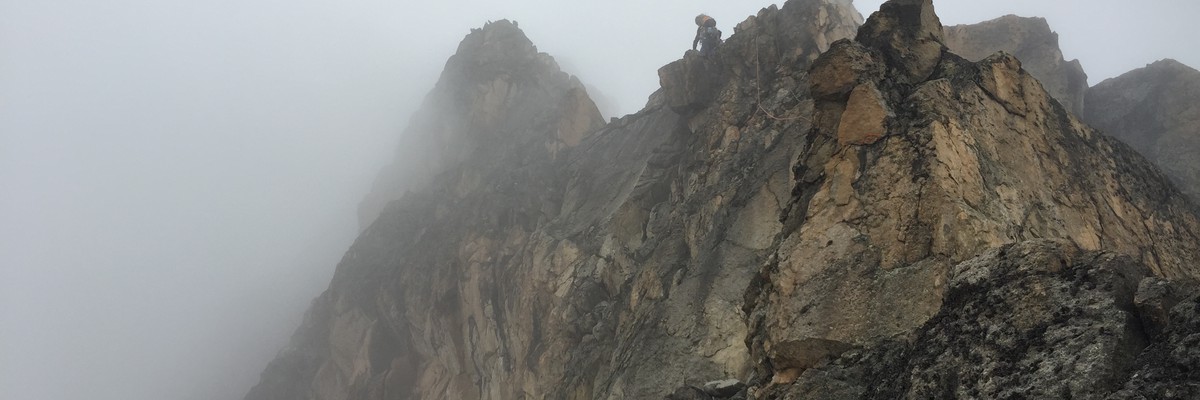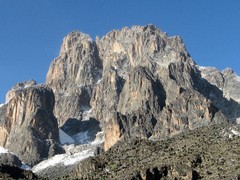Season: Christmas to mid-March.
Time: Allow 6-7 hours for the ascent of Nelion and a further 3 hours for reaching Batian and returning to Nelion. It’s advisable to spend a night in the Howell Hut on Nelion’s summit.
The route is rather complex, and much of the climbing is not above grade III. With difficult ice conditions the Gate of the Mists may be IV. An ice-axe and crampons are recommended. Throughout the climb care is needed to avoid dislodging loose stones.
From the Austrian Hut cross the Lewis Glacier and scramble up the scree, which has many precariously balanced boulders and can be dangerous in half-light. Start climbing up a side groove about 55 m left of the obvious Brocherei Couloir. 18 m of easy climbing brings one to a wide, boulder-strewn ter race, at the left end of which is a gully (Donkey Walk) leading up to the left. Scramble up the gully for 25 m, then a mounting traverse back to the right up a series of easy ledges on the face.
A move round a corner (III) leads to the foot of Mackinder’s Chimney. Instead of climbing the chimney, descend 21/2m and traverse right 6 m to a platform below the Rabbit Hole then climb a rib immediately right of the Rabbit Hole (III) and follow easy rocks to a platform at the top of Mackinder’s Chimney. One o’clock Gully (quite easy, unless ice-filled) now leads up right for 40 m. Where it steepens, mount the left wall then traverse back right to reach block steps leading up to the crest of the main ridge. When it appears obvious, make a long traverse right across slab then up toward the base of Mackinder’s Gendarme. A tin shelter (Baillie’s Bivi), is found just below the notch beneath Mackinder’s Gendarme on the main ridge. This is approximately half-way up Nelion. Turn the Gendarme on the left by first descending 7 to 10 m and then up a large gully.
Most parties nowadays follow the De Graaf's Variation, which is the easiest and most direct route (IV inf.). Avoid Shipton’s and Rickety Cracks by a traverse left for some 12 m out of a large gully, following the ascent of the square-cut groove for about 20 m and then straightforward climbing to the ridge leading to the Amphitheatre.
Alternatively, instead of traversing 12 m out of the large gully, continue up the gully to two short chimneys known as Shipton's Crack's (IV inf.), which lead to a small platform (Windy Gap), between the Gendarme and the main face, recent years many parties have found the traverse of the Gendarme the easiest and quickest way of reaching Windy Gap. From Windy Gap climb 2 m over a bulge on the face to reach a ledge; follow this right until peters out on the main face From here Rickety Crack (IV inf.) leads upwards for about 8 m to a platform. (A jammed nose of rock 2 m above the bottom of the crack can be used for protection on the first awkward exposed moves up the crack). Climb 30 m up a ridge to the right leading to a point overlooking the Amphithatre.
Belay at the edge of the Amphitheatre and climb down 8 m to the right (III). Work round the back wall of the Amphitheatre to cracks leading up left into the bed of the gully. Ascend the gully, much loose rock, for two pitches to a plat- form A 5 m wall is climbed by a shallow chimney (III), followed by a scramble over loose rock to a col overlooking the Diamond Glacier. Turn sharp right and up easy rocks to the summit of Nelion.
Variations: The Crack directly above Windy Gap has also been climbed out of season (Pfeffer and Pauer, August 1957). The chimney to the left of the point where the route traverses right into the Amphitheatre was climbed first by E. Sladen in 1938.
The summit of Batian is only 140 m away in a horizontal distance, but drop of nearly as many metres 'nto the Gate of the Mists is involved. The ridge may be followed from Nelion, traversing down on the north side, then turning towards the Gate. Keep under an overhanging cliff and descend to a boss of rock just above the Gate. Climb down this (III or IV), possibly leaving a rope to facilitate the return, as there’s usually ice in the cracks. Cross the snow in the Gate (which may be corniced); as the icework is less than a rope’s length it is possible to belay from either side. Traverse round the base of the Tower, on its north side, up scree or snow, and over the ridge behind the Tower onto the South Face of Batian. Ledges lead left across the face into a gully. This is then followed to the summit, but if it’s ice-filled take the wall to the right of the gully and chimney, taking care because of loose rock.
There is now a bolted abseiling route down Nelion. Follow arrows. Best done with 25 metre abseils. See here for details: https://www.summitpost.org/nelion-descent/160054
Major variations: Two variations have been done to join the Normal Route at Mackinder's Gendarme.
1a - East Ridge: This ridge of Nelion which rise from Flake Col consists of very loose shattered rock. Start 50 m left to the col and ascend ramp to ridge. The first four pitches are on poor rock and the fifth and sixth pitches are the most difficult. Climb the ridge then abseil into the top of the Brocherel Couloir and traverse to Mackinder's Gendarme. (A.G. Chinery and T. Welker, 14th Jan. 1965. Grade IV sup.).
1b - Brocherel Couloir: This prominent couloir right of the Normal Route start was climbed by P. Snyder and R. Collister in 1974. Grade V.
FA: E.E. Shipton & R Wyn Harris, 1929




